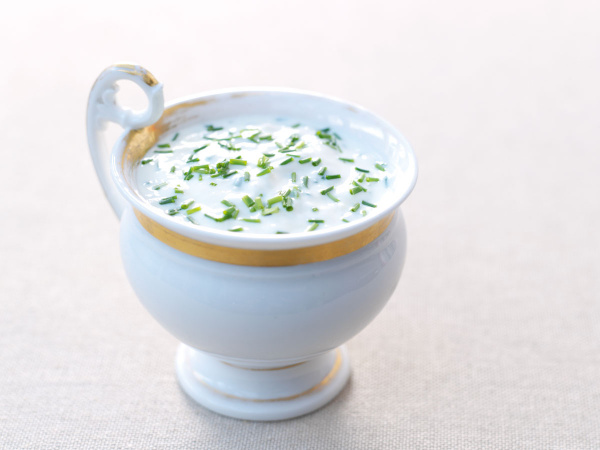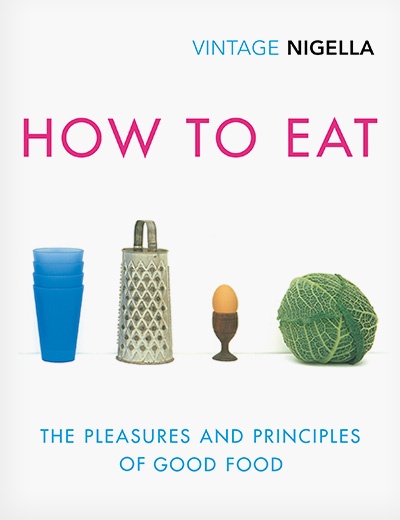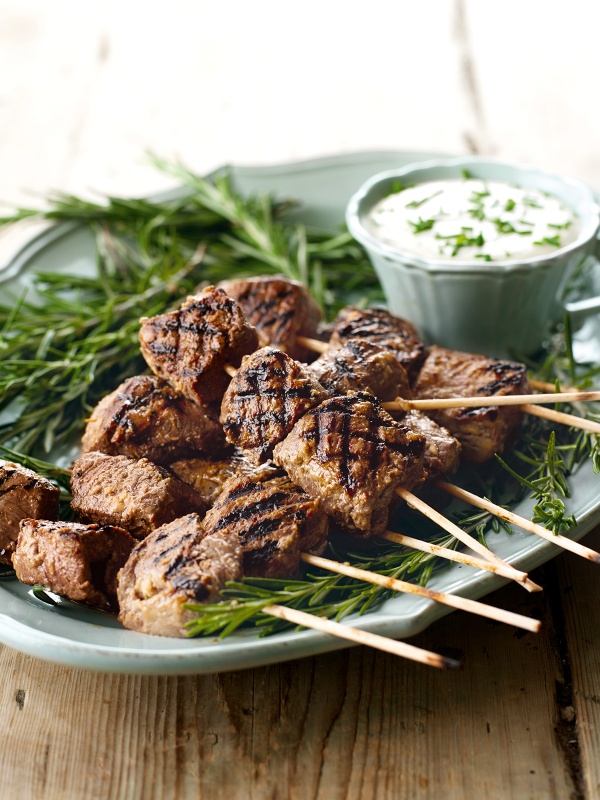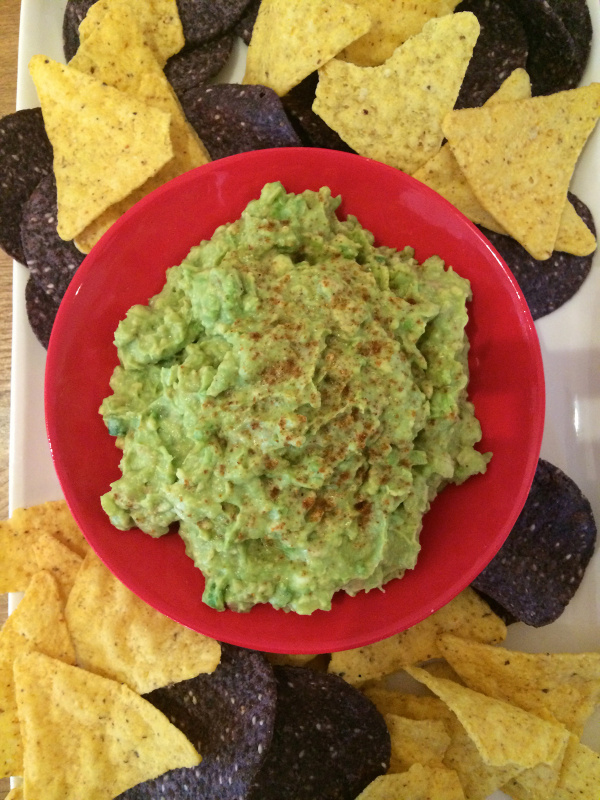Fresh Horseradish Sauce With Chives
by Nigella. Featured in HOW TO EATIntroduction
Until I was in my mid-thirties, the only horseradish sauce I knew was the one that came out of jar. And while there is certainly nothing wrong with jarred horseradish sauce, the fresh stuff is just a world apart. And it’s even better when it’s crammed with finely chopped chives. I came across the combination in a wonderful Arabella Boxer recipe, as I wrote about in How To Eat, and this is a slight rejig of it.
I have specified a whole horseradish root here even though you need grate only 5cm/2 inches (to start off with at least). Should you happen to have a bit of horseradish root knocking about the place, you don’t have to go out and buy (or pick) another one, but you do need enough left on it to be able to have something to grab onto while you grate. And you may well want to grate in more horseradish than I’ve specified; I like this best really strong, and grate more in with abandon.
Please don’t think that this sauce’s only use is as an accompaniment to roast beef, heavenly though that is. It’s as wonderful with roast pork or smoked (and, indeed, fresh) mackerel, and I absolutely adore it in a baked potato or with beetroot. And I have lately started eating it as a dip, with blue corn chips, and it is out of this world.
Actually, a dollop of this is a great way of zhuzzing up many vegetables, especially roast butternut or sweet potato, and you could easily use oat-milk crème fraiche to create a vegan version.
Finally, I don’t think this is worth doing with ready-grated fresh horseradish (not that it’s very easy to find, anyway). If you can’t get a fresh horseradish root, stick to bottled.
You do have quite a lot of sauce here, but I always find everyone eats so much more than you’d think. Besides, despite its many delicious applications, I do feel that the recipe has to yield enough for a proper roast beef lunch!
Until I was in my mid-thirties, the only horseradish sauce I knew was the one that came out of jar. And while there is certainly nothing wrong with jarred horseradish sauce, the fresh stuff is just a world apart. And it’s even better when it’s crammed with finely chopped chives. I came across the combination in a wonderful Arabella Boxer recipe, as I wrote about in How To Eat, and this is a slight rejig of it.
I have specified a whole horseradish root here even though you need grate only 5cm/2 inches (to start off with at least). Should you happen to have a bit of horseradish root knocking about the place, you don’t have to go out and buy (or pick) another one, but you do need enough left on it to be able to have something to grab onto while you grate. And you may well want to grate in more horseradish than I’ve specified; I like this best really strong, and grate more in with abandon.
Please don’t think that this sauce’s only use is as an accompaniment to roast beef, heavenly though that is. It’s as wonderful with roast pork or smoked (and, indeed, fresh) mackerel, and I absolutely adore it in a baked potato or with beetroot. And I have lately started eating it as a dip, with blue corn chips, and it is out of this world.
Actually, a dollop of this is a great way of zhuzzing up many vegetables, especially roast butternut or sweet potato, and you could easily use oat-milk crème fraiche to create a vegan version.
Finally, I don’t think this is worth doing with ready-grated fresh horseradish (not that it’s very easy to find, anyway). If you can’t get a fresh horseradish root, stick to bottled.
You do have quite a lot of sauce here, but I always find everyone eats so much more than you’d think. Besides, despite its many delicious applications, I do feel that the recipe has to yield enough for a proper roast beef lunch!

Share or save this
Ingredients
Serves: 400ml / 1⅔ cups
- 300 millilitres creme fraiche or sour cream (not fridge-cold)
- 1 fresh horseradish root (see intro)
- 1¼ teaspoons Dijon mustard
- 1 pinch of caster sugar
- 1 teaspoon Maldon sea salt flakes or ½ teaspoon fine sea salt (or more to taste)
- 1 x 25g bunch chives (chopped)
- 1⅓ cups creme fraiche or sour cream (not fridge-cold)
- 1 fresh horseradish root (see intro)
- 1¼ teaspoons Dijon mustard
- 1 pinch of granulated sugar
- 1 teaspoon kosher salt or ½ teaspoon fine sea salt (or more to taste)
- ½ cup chives (chopped)
Method
- Take the crème fraiche or sour cream out of the fridge in time for it to lose its chill, tip it into a bowl, and give it a vigorous stir to loosen it a little; if you’re using sour cream, it will be more fluid anyway so you won’t have to beat it.
- Peel a 5cm / 2 inch length of skin from the horseradish root, but don’t cut the chunk off. Finely grate it onto a board, or into the bowl of crème fraiche if you prefer. I go for the board simply as it stops me spraying the work surface with horseradish, and I use a fine microplane grater that I rest on the board, which makes life a little easier. Nevertheless, the grating does require patience and elbow grease; and it will certainly clear the nasal passages and make your eyes run a little.
- Stir the grated horseradish into the crème fraîche, or sour cream, along with the mustard, caster sugar and the salt, and taste to see if you want to add more salt or horseradish. I do this a little in advance, but I suggest you don’t get a-grating and mixing more than an hour before eating. Just before you serve, finely chop the chives, stir most of them into the sauce, decant into a serving bowl and sprinkle the few remaining chives on top.
- Take the crème fraiche or sour cream out of the fridge in time for it to lose its chill, tip it into a bowl, and give it a vigorous stir to loosen it a little; if you’re using sour cream, it will be more fluid anyway so you won’t have to beat it.
- Peel a 5cm / 2 inch length of skin from the horseradish root, but don’t cut the chunk off. Finely grate it onto a board, or into the bowl of crème fraiche if you prefer. I go for the board simply as it stops me spraying the work surface with horseradish, and I use a fine microplane grater that I rest on the board, which makes life a little easier. Nevertheless, the grating does require patience and elbow grease; and it will certainly clear the nasal passages and make your eyes run a little.
- Stir the grated horseradish into the crème fraîche, or sour cream, along with the mustard, granulated sugar and the salt, and taste to see if you want to add more salt or horseradish. I do this a little in advance, but I suggest you don’t get a-grating and mixing more than an hour before eating. Just before you serve, finely chop the chives, stir most of them into the sauce, decant into a serving bowl and sprinkle the few remaining chives on top.
Additional Information
MAKE AHEAD:
The sauce will keep in an airtight container in the fridge for up to 5 days. However, horseradish loses its heat over time so the sauce is at its best on the day it is made.
MAKE AHEAD:
The sauce will keep in an airtight container in the fridge for up to 5 days. However, horseradish loses its heat over time so the sauce is at its best on the day it is made.






Tell us what you think
Thank you {% member.data['first-name'] %}.
Explore more recipesYour comment has been submitted.